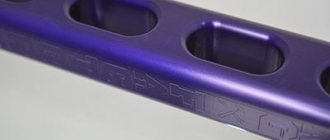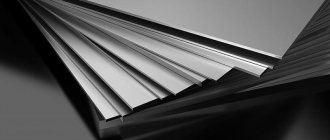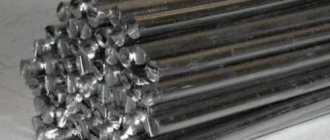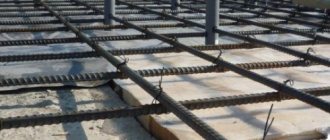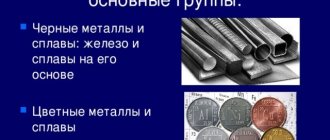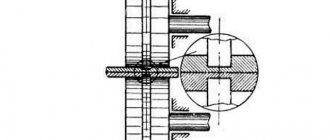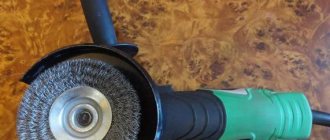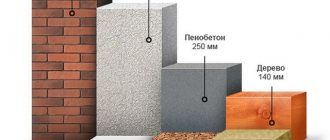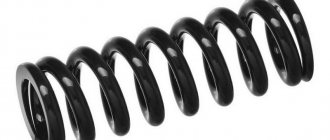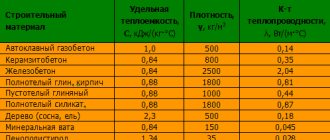Chemical resistance of aluminum and its alloys.
The standard electrode potential of aluminum is -1.66V, i.e. it is a fairly active metal. However, due to its tendency to passivate, aluminum can be resistant in many environments.
In its normal state, the surface of aluminum is covered with a layer of oxide with a thickness of 5 to 100 nanometers. The film is firmly adhered to the metal and covers it with a continuous layer. A film on aluminum is formed at pH=3-9. The corrosion resistance of aluminum is higher for the most pure aluminum (AB1 and AB2) with an aluminum content of 99.9-99.85%, respectively, and lower for technically pure A00 and A0 with an aluminum content of 99.7-99.6, respectively. Duralumin (duralumin, 2-7% copper) has low corrosion resistance. Silumin casting alloys (0.8-13% silicon) hold up well in oxidizing environments.
Aluminum struts:
- In atmospheric conditions;
- In environments containing H2S, SO2, NH3;
- In water when heated;
- In solutions of salts with oxidizing properties - chromate, nitrate;
- In concentrated solutions of nitric and sulfuric acids (have oxidizing properties);
- In dilute sulfuric acid at 20°C;
- In oleum up to 200o C;
- In phosphoric acid at room temperature;
- In acetic acid with a concentration of 1-99% by weight at temperatures up to 65o C;
- In boiling acetic acid only at concentrations of 98-98.8% wt;
- In formaldehyde;
- In dry hydrogen chloride.
Aluminum is unstable:
- In neutral solutions of salts containing halides - fluorides, chlorides, bromides, iodides;
- In sulfuric acid of medium concentration;
- In boiling acetic acid up to 98% mass and above 98.8% mass;
- In droplet liquid and vapor mercury (corrosion of aluminum in acetic acid begins in the presence of mercury 0.000004% wt;
- In alkalis (with hydrogen depolarization);
- In hydrofluoric acid;
- In contact with copper, iron and their alloys.
1.4.9. Corrosion resistance of materials
(Prof., Doctor of Chemical Sciences V.S. Zotikov
)
Table 1.4.62 presents data on the corrosion resistance of the most common metallic and non-metallic materials in various liquid and gaseous media. For each environment, the corrosion resistance of metals and alloys, and then non-metallic materials, is first characterized. Data for metals refer to materials containing at least 99% base material. For the most common alloys, specific grades are indicated; for experimental alloys, the content of the main components is given.
The names of chemical media are arranged in alphabetical order, and in contrast to the nomenclature of complex compounds adopted in recent years in chemistry, the name begins with the cation.
In the column “ Concentration. Pressure
» the mass concentration of the main substance or impurity is given, indicating its name and pressure in MPa. Additionally, factors affecting the corrosion resistance of materials (medium aeration, pH, presence of atmospheric oxygen, etc.) are reported. In the case where the solvent of the aggressive substance is not specified, an aqueous solution is meant. A dash means that the information relates to a pure product. The term “phase” characterizes the state of aggregation of a chemical medium.
In the column “ Rate and nature of corrosion. Durability of materials
» the corrosion rate (mm/year), the nature of corrosion and the chemical resistance of materials are presented.
Conventions and abbreviations
nature of corrosion: t - pitting corrosion, i - pitting corrosion, n - uneven corrosion, mk - intergranular corrosion, cr - corrosion cracking;
chemical resistance of materials: C - resistant, OS - relatively resistant, N - unstable;
state of aggregation of the substance: T - solid phase; F—liquid phase; G - gaseous phase;
physical parameters: T
kip - boiling point;
Tpl
—melting temperature;
p
—pressure;
quantitative characteristics of the environment: sat. - saturated;
rubber based on rubbers: BK - butyl rubber, NK - natural, PS - polysulfide, SKB - butadiene, SKI - isoprene, SKN - butadiene-nitrile, SKS - butadiene-styrene, SKT - organosilicon, SKU - urethane, SKF - fluorine rubber, SKEP - ethylene-propylene, HP - chloroprene, HSPE - chlorosulfonated polyethylene.
List of chemical media
| Nitrogen N2 | Potassium hydroxide KOH | Sodium hypochlorite NaClO |
| Nitrogen oxides | Potassium nitrate KNO3 | Sodium carbonate Na2CO3 |
| Allyl chloride CH2=CHCH2Cl | Potassium sulfate K2SO4 | Sodium nitrate NaNO3 |
| Aluminum sulfate Al2(SO4)3 | Potassium chloride KCl | Sodium orthophosphate Na3PO4 |
| Aluminum chloride AlCl3 | Calcium hydroxide Ca(OH)2 | Sodium perchlorate NaClO4 |
| Ammonia NH3 | Calcium hypochlorite Ca(ClO)2 | Sodium sulfate Na2SO4 |
| Ammonia NH3 aqueous solutions | Calcium chloride CaCl2 | Sodium chlorate NaClO3 |
| Ammonium hydrodifluoride NH4HF2 | Acid | Sodium chloride NaCl |
| Ammonium nitrate NH4NO3 | nitrogen HNO3 | Nickel(II) sulfate NiSO4 |
| Ammonium orthophosphate (NH4)3PO4 | boric H3BO3 | Nickel(II) chloride NiCl2 |
| Ammonium sulfate (NH4)2SO4 | hydrogen bromide HBr | Sulfur dioxide SO2 |
| Ammonium fluoride NH4F | wine HOOCCH(OH)CH(OH)COOH | Hydrogen sulfide H2S |
| Ammonium chloride NH4Cl | hexafluorosilicon H2SiF6 | Alcohol |
| Acetic anhydride (CH3CO)2O | hydrogen iodide HI | methyl CH3OH |
| Aniline C6H5NH2 | lemon HOC(CH2COOH)2COOH | ethyl C2H5OH |
| Acetaldehyde CH3CHO | maleic COOHCH=CHCOOH | Carbon tetrachloride CCl4 |
| Acetylene CHº CH | oil CH3(CH2)2COOH | 1,1,2-Trichloroethane CH2ClCHCl2 |
| Acetone CH3COCH3 | milky CH3CH(OH)COOH | Trichlorethylene CHCl=CCl2 |
| Barium chloride BaCl2 | monochloroacetic ClCH2COOH | Phenol C6H5OH |
| Petrol | formic HCOOH | Formaldehyde HCHO |
| Benzene C6H6 | orthophosphoric H3PO4 | Fluorine F2 |
| Bromine Br2 | propionic CH3CH2COOH | Hydrogen fluoride HF |
| Hydrogen bromide HBr (gas) | sulfuric H2SO4 | Freons: |
| Water H2O | trichloroacetic CCl3COOH | difluorodichloromethane CF2Cl2 (R12) |
| Sea water | acetic CH3COOH | difluoromethane CF2H2 (R32) |
| Hydrogen H2 | hydrogen fluoride HF | difluorochloromethane CF2ClH (R22) |
| Hydrogen peroxide H2O2 | chlorine HClO4 | octafluoropropane CF3CF2CF3 (R218) |
| Glycerol CHOH(CH2OH)2 | hydrochloric HCl | 1,1,1,2-tetrafluoroethane CF3CFH2 (R134a) |
| 1,2-Dichloroethane ClCH2CH2Cl | chlorosulfonic SO2Cl(OH) | 1,1,2-trifluorotrichloroethane CF2ClCFCl2 (R113) |
| 1,2-Dichloroethylene ClCH=CHCl | oxalic HOOCCOOH | fluorotrichloromethane CFCl3 (R11) |
| Iron(III) nitrate Fe(NO3)3 | Lithium chloride LiCl | Chlorine Cl2 |
| Iron(II) sulfate FeSO4 | Magnesium chloride MgCl2 | Hydrogen chloride HCl (gas) |
| Iron(III) sulfate Fe2(SO4)3 | Copper(II) sulfate CuSO4 | Chloroform CHCl3 |
| Iron(III) chloride FeCl3 | Methylene chloride CH2Cl2 | Zinc chloride ZnCl2 |
| Iodine I2 | Methyl chloride CH3Cl | Ethylene H2C=CH2 |
| Hydrogen iodide HI (gas) | Sodium hydroxide NaOH | Ethyl chloride C2H5Cl |
Table 1.4.62
Corrosion resistance of materials
*
They are formed during the thermal dissociation of dinitrogen tetroxide N2O4 and are a mixture of N2O4, NO2, NO, N2O3, the ratio of the components of which depends on temperature and pressure.
Table 1.4.63
Solubility of hydrogen in metals
Data are given for a gaseous medium (phase G) at pressure p
= 0.1 MPa.
Table 1.4.64
Corrosion at contacts between metals and alloys
Digital designations: 0 - when the specified metals and alloys come into contact, corrosion does not occur; 1 - slight corrosion, but contact is acceptable if the moving parts are coated with lubricant and the stationary parts are coated with varnish; 2 - severe corrosion, metals and alloys must be separated with protective coatings.
Operating conditions: P - operation in heated and ventilated rooms, air temperature 10–25 ° C, relative humidity 15–65%; H - operation under canopies and in unheated rooms, the environment is characterized by the absence of exposure to precipitation and solar radiation, the atmosphere is polluted with a small amount of industrial gases, the ambient temperature is from –60 to +60 ° C, the average relative humidity is 95 ± 3%; A - outdoor operation, the environment is characterized by exposure to precipitation, sea fog, solar radiation, the atmosphere is polluted with industrial gases, dust, ambient temperature from –60 to +80 ° C, average relative humidity 95 ± 3%.
| Contacting metals and alloys | Silver, gold, palla dium and rhodium plating | Copper, brass, bronze | Nickel plating | Chrome coating (multi-layer) | Zinc coating (chrome plated) | Cadmium coating (chromated) | Tin and tin-lead coating | Aluminum and its alloys | Titanium and its alloys | Nitrided steel | Stainless steel (chrome-nickel) | |||||||||||||||||||||||||
| oxidized | non-oxidized | |||||||||||||||||||||||||||||||||||
| P | N | A | P | N | A | P | N | A | P | N | A | P | N | A | P | N | A | P | N | A | P | N | A | P | N | A | P | N | A | P | N | A | P | N | A | |
| Silver, gold, palladium and rhodium plating | 0 | 0 | 0 | 0 | 0 | 0 | 0 | 0 | 0 | 0 | 0 | 0 | 2 | 2 | 2 | 2 | 2 | 2 | 0 | 0 | 0 | 1 | 1 | 2 | 2 | 2 | 2 | 0 | 0 | 0 | 1 | 2 | 2 | 0 | 0 | 0 |
| Copper, brass, bronze | 0 | 0 | 0 | 0 | 0 | 0 | 0 | 0 | 0 | 0 | 0 | 0 | 2 | 2 | 2 | 2 | 2 | 2 | 0 | 0 | 0 | 0 | 1 | 2 | 1 | 1 | 2 | 0 | 0 | 0 | 1 | 1 | 2 | 0 | 0 | 0 |
| Nickel plating | 0 | 0 | 0 | 0 | 0 | 0 | 0 | 0 | 0 | 0 | 0 | 0 | 0 | 1 | 2 | 0 | 1 | 2 | 0 | 0 | 0 | 0 | 0 | 1 | 0 | 1 | 2 | 0 | 0 | 0 | 0 | 0 | 0 | 0 | 0 | 0 |
| Chrome plating (multi-layer) | 0 | 0 | 0 | 0 | 0 | 0 | 0 | 0 | 0 | 0 | 0 | 0 | 0 | 1 | 1 | 0 | 1 | 1 | 0 | 0 | 0 | 0 | 0 | 0 | 0 | 1 | 2 | 0 | 0 | 0 | 0 | 0 | 0 | 0 | 0 | 0 |
| Zinc coating (chromated) | 2 | 2 | 2 | 2 | 2 | 2 | 0 | 1 | 2 | 0 | 1 | 1 | 0 | 0 | 0 | 0 | 0 | 0 | 0 | 1 | 2 | 0 | 1 | 1 | 0 | 0 | 0 | 1 | 1 | 2 | 0 | 0 | 0 | 0 | 1 | 2 |
| Cadmium coating (chromated) | 2 | 2 | 2 | 2 | 2 | 2 | 0 | 1 | 2 | 0 | 1 | 1 | 0 | 0 | 0 | 0 | 0 | 0 | 0 | 1 | 1 | 0 | 1 | 1 | 0 | 0 | 0 | 1 | 1 | 2 | 0 | 0 | 1 | 0 | 1 | 1 |
| Tin and tin-lead coating | 0 | 0 | 0 | 0 | 0 | 0 | 0 | 0 | 0 | 0 | 0 | 0 | 0 | 1 | 2 | 0 | 1 | 1 | 0 | 0 | 0 | 0 | 0 | 0 | 0 | 1 | 1 | 0 | 0 | 0 | 0 | 0 | 1 | 0 | 0 | 0 |
| Aluminum and its alloys, oxidized | 1 | 1 | 2 | 0 | 1 | 2 | 0 | 0 | 1 | 0 | 0 | 0 | 0 | 1 | 1 | 0 | 1 | 1 | 0 | 0 | 0 | 0 | 0 | 0 | 0 | 0 | 0 | 0 | 0 | 0 | 0 | 0 | 0 | 0 | 0 | 1 |
| Aluminum and its alloys, non-oxidized | 2 | 2 | 2 | 1 | 1 | 2 | 0 | 1 | 2 | 0 | 1 | 2 | 0 | 0 | 0 | 0 | 0 | 0 | 0 | 1 | 1 | 0 | 0 | 0 | 0 | 0 | 0 | 1 | 1 | 2 | 0 | 0 | 0 | 0 | 1 | 2 |
| Titanium and its alloys | 0 | 0 | 0 | 0 | 0 | 0 | 0 | 0 | 0 | 0 | 0 | 0 | 1 | 1 | 2 | 1 | 1 | 2 | 0 | 0 | 0 | 0 | 0 | 0 | 1 | 1 | 2 | 0 | 0 | 0 | 0 | 0 | 1 | 0 | 0 | 0 |
| Nitrided steel | 1 | 2 | 2 | 1 | 1 | 2 | 0 | 0 | 1 | 0 | 0 | 0 | 0 | 0 | 0 | 0 | 0 | 1 | 0 | 0 | 1 | 0 | 0 | 0 | 0 | 0 | 0 | 0 | 0 | 1 | 0 | 0 | 0 | 0 | 0 | 1 |
| Stainless steel (chrome-plated) | 0 | 0 | 0 | 0 | 0 | 0 | 0 | 0 | 0 | 0 | 0 | 0 | 0 | 1 | 2 | 0 | 1 | 1 | 0 | 0 | 0 | 0 | 0 | 1 | 0 | 1 | 2 | 0 | 0 | 0 | 0 | 0 | 1 | 0 | 0 | 0 |
Literature
1. Recommendations for the selection of chemically resistant materials for gaskets: In 2 books. / Ed. A.V. Goryainova. M.: Mechanical Engineering, 1980. Book. 1. 368 p.
2. Migai L.L., Taritsyna T.A. Corrosion resistance of materials in halogens and their compounds: Handbook. M.: Metallurgy, 1988. 304 p.
3. Ruskol Yu.S. Titanium structural alloys in chemical industries: Reference publication. M.: Khimiya, 1989. 288 p.
4. Tufanov D.G. Corrosion resistance of stainless steels, alloys and pure metals. M.: Metallurgy, 1982. 352 p.
5. Increasing the operational reliability of equipment operating in aggressive environments: Sat. scientific tr. / Ed. V.S. Zotikova, M.N. Ignatova. Perm: Perm Polytechnic Publishing House. in-ta. 1990. 256 p.
6. Rachev H., Stefanova S. Handbook on corrosion / Translation from Bulgarian. Ed. S.I. Neikovsky. M.: Mir, 1982. 520 p.
7. Nagai I.N., Tomashov N.D., Seledtsov D.K., Kochergina V.M. // Protection of metals. 1981. T. 17, no. 5. pp. 530–537.
8. Barabanov V.G., Zotikov V.S., Limonova L.P. and others. Corrosion of equipment in the production of halogen-containing substances: Reference publication / Ed. V.S. Zotikova. St. Petersburg: TEZA, 1998. 252 p.
9. Corrosion resistance of chemical production equipment. Corrosion under the influence of coolants, refrigerants and working fluids: Reference publication / Ed. A.M. Sukhotina, V.M. Berenblit. L.: Chemistry, 1988. 360 p.
10. Corrosion of structural materials. Gases and inorganic acids: Directory: In 2 books. / V.V. Batrakov, V.P. Batrakov et al. Inorganic acids. M.: Metallurgy, 1990. Book. 2. 320 s.
11. Mamulova N.S. etc. All about corrosion: Handbook. St. Petersburg: Khimizdat, 2000. 577 p.
Chemical resistance of copper and its alloys.
The standard copper potential is +0.52/0.337V for the reduction of cuprous and divalent copper, respectively. Typically, during corrosion, copper goes into solution in its divalent form. The standard potential of copper in a solution of 3% sodium chloride is +0.05V, and in a solution of 1N hydrochloric acid is +0.15V. Therefore, copper under normal conditions does not displace hydrogen from solutions, i.e. cannot corrode with hydrogen depolarization. The ability to passivate copper is weakly expressed. Resistance to gas corrosion of copper increases when alloyed with beryllium, magnesium and aluminum.
Brass is an alloy of copper and zinc. The introduction of aluminum, manganese, and nickel into brass increases the resistance of the alloy to atmospheric corrosion, and silicon to sea water.
Copper is resistant:
- In saline solutions;
- In dilute non-oxidizing acids;
- In formaldehyde.
Copper is unstable:
- In solutions where it can form complexes (cyanides, ammonia);
- In solutions of oxidizing agents - nitric acid, hydrogen peroxide;
- In the presence of dissolved oxygen (especially when blowing it through the solution);
- In chromic acid;
- In formic acid;
- In sulfides, polysulfides, sulfur dioxide.
316 stainless steel
Stainless steel
In all grades of stainless steel, the main components responsible for the corrosion resistance and ductility of the metal are chromium and nickel. The addition of >10% chromium makes the steel stainless by creating a layer on the surface containing large amounts of chromium oxide. This layer is formed as a result of the reaction of chromium contained in the alloy with oxygen from the atmospheric air. It gives the steel a property that makes it stainless. The addition of nickel provides good ductility and improved forming and welding properties.
However, not all bar stock is created equal. Nickel and chromium content of Swagelok 316/316L stainless steel tube fittings and instrument valves exceeds the minimum requirements of ASTM standards for rods and forgings.
It should be taken into account that although stainless steel of different grades is not subject to complete corrosion, local corrosion may occur on it.
To combat:
continuous corrosion; hydrogen embrittlement; intergranular corrosion
Material matters
The risk of stress corrosion cracking increases at high chloride concentrations, temperatures and tensile stresses. All grades of stainless steel are susceptible to stress corrosion cracking. We have tested Swagelok pressure tubing fittings for SCC resistance and found excellent results.
Swagelok 316 stainless steel tube fittings and instrument valves exceed the minimum requirements of ASTM standards.
Chemical resistance of nickel and its alloys.
The standard potential of nickel is -0.25V. Nickel corrosion mainly occurs with oxygen depolarization.
Nickel resistant:
- In non-oxidizing dilute acids (hydrochloric acid up to 15%, sulfuric acid up to 70%);
- In a number of organic acids, alcohols;
- In any alkalis at any temperature.
Nickel is unstable:
- In the presence of iron (III) chloride, copper (II) chloride, mercuric (II) chloride, silver nitrate, NaClO;
- In oxidizing acids (for example, nitric acid);
- In concentrated non-oxidizing acids.
Alloy C-276
Nickel alloys
Alloy C-276 (Hastelloy® C-276) contains nickel, molybdenum and chromium. The high molybdenum content makes this alloy particularly resistant to pitting and crevice corrosion. It is one of the few materials that is resistant to the corrosive effects of wet chlorine gas, hypochlorite and chlorine dioxide.
- Resistance to oxidizing and acidic working environments.
- Plasticity, toughness and strength at high temperatures.
- Resistant to crevice and pitting corrosion, sulfide stress corrosion (SSC) and intergranular corrosion (IGC)
- Suitable for use in sour gas environments (NACE MR0175/ISO 15156)
Please note that this alloy is NOT recommended for use in highly oxidising environments such as hot and concentrated nitric acid.
To combat:
continuous corrosion; local corrosion; stress corrosion cracking; Corrosion due to high sulfur environments
Chemical resistance of tin and its alloy with bismuth.
The standard potential of tin is -0.136V. Pure tin is compact at temperatures above +13o C (in the form of white tin). Below this temperature, especially at -48o C, tin actively transforms into the allotropic modification “gray tin”, which has a powdery structure. To eliminate this phenomenon, tin is doped, for example, with a small amount of bismuth (0.5-2%). Tin is weakly passivated.
Tin is stable:
- In natural waters;
- In solutions of neutral salts;
- In food environments;
- In dilute solutions of sulfuric and hydrochloric acids;
- In organic acids.
Method 1
The method makes it possible to evaluate the resistance of coatings to corrosion when exposed to changes in temperature values, high air humidity and destructive solar exposure over a short period of time . Certain conditions are established for testing. The temperature is 40°C and the air humidity is 97%.
The test consists of 5 cycles. Where each cycle begins with keeping the sample under the specified conditions for 1 hour. After this, the heating is turned off and the product is left for another 2 hours. Next they are placed in a light chamber with dir. 3-17 for another 2 hours. As a final step, the samples are kept in air for 19 hours under conditions with a temperature range of 15-30°C and air humidity of up to 80%.
After 5 cycles, samples are evaluated.
Chemical resistance of lead.
The standard lead potential is -0.126V. The corrosion resistance of lead is largely determined by the stability of its corrosion products.
Lead resistant:
- In sulfuric acid and sulfates;
- In phosphoric acid and phosphates;
- In hydrochloric acid up to 10%;
- In hard waters with calcium sulfate;
- In silicic acid;
- In industrial atmospheres with hydrogen sulfide, sulfur dioxide and sulfuric acid.
Lead is unstable:
- In nitric acid;
- In acetic acid;
- In alkalis;
- In sulfuric acid above 96% and oleum;
- In hot sulfuric acid up to 80%;
- In hydrochloric acid over 10%;
- In groundwater with organic acids;
- In underground waters saturated with carbon dioxide.
2507 Super Duplex Stainless Steel Alloy
Stainless steel
Duplex stainless steel has a two-phase microstructure consisting of austenite and ferrite grains. This structure gives these materials a combination of attractive properties, including strength, ductility and corrosion resistance.
Super duplex ferritic-austenitic stainless steel 2507 is excellent for use in highly corrosive environments. Its composition includes nickel, molybdenum, chromium, nitrogen and manganese, which provides excellent resistance to solid, pitting and crevice corrosion, stress corrosion, and stress cracking while maintaining weldability.
- Increased yield strength and tensile strength at increased pressure ratings.
- Compared to 316/316L steel tubing of the same outside diameter and pressure rating, the thinner wall thickness allows for increased fluid flow.
- Weldability.
- Applications with temperatures up to 482°F (250°C).
- Higher thermal conductivity/lower coefficient of thermal expansion compared to 316 stainless steel.
- Suitable for use in sour gas environments (NACE MR0175/ISO 15156)
- Swagelok Alloy 2507 products are offered in rods and forgings that meet the NORSOK M-650 steel supplier standard.
Alloy 2507's mechanical properties make it an excellent choice for high-pressure marine and subsea applications where corrosion, high flow rates and weight must be considered.
To combat:
continuous corrosion; local corrosion; stress corrosion cracking
6. Chemical resistance of zinc.
The standard potential of zinc is -0.76V. Zinc can corrode with both hydrogen and oxygen depolarization. It is rarely used in its pure form, mainly in chromated or chromium-plated form, as well as in passivated form using chromium-free passivators.
Zinc stable:
- In fresh water up to 55°C;
- In clean and sea dry atmospheres.
Zinc is unstable:
- In acidic environments (pH below 7);
- In alkaline environments (at pH above 12);
- In industrial environments containing SO2, SO3, HCl;
- In sea water and humid marine atmosphere.
Alloy 400
Nickel alloys
Alloy 400 (Monel® 400) is a copper-nickel alloy that is known for its exceptional resistance to hydrofluoric acid as well as stress corrosion cracking and pitting in most clean and process waters.
- Strength and corrosion resistance over a wide range of temperatures and operating environments.
- Preservation of mechanical properties at temperatures below zero.
It should be borne in mind that standing sea water, according to the results of experiments, contributes to the occurrence of crevice and pitting corrosion in this alloy.
To combat:
continuous corrosion; local corrosion; stress corrosion cracking; Corrosion due to high sulfur environments
Chemical resistance of cadmium.
The standard potential of cadmium is -0.4V. Cadmium has a low passivation ability. Corrosion behavior is similar to zinc, however, as the pH decreases, the corrosion rate decreases. Cadmium is more stable in acidic and neutral environments than zinc. In alkaline environments, cadmium is quite stable. The most important thing is that cadmium, unlike zinc, is stable in sea water and this determines its main use. In the presence of SO2 and SO3, cadmium quickly corrodes. Like zinc, cadmium coatings are used in chromated form.
6Mo alloys
Stainless steel
6-Moly (6Mo) alloys are super-austenitic stainless steels that contain at least 6% molybdenum and have a PREN value of at least 40. Alloy 6HN (UNS N08367) contains 6 weight percent more nickel ( Ni) than alloy 254 (UNS S31254). Due to this increased nickel content, the 6HN alloy has increased stability in terms of the formation of unwanted intermetallic phases. Alloy 6HN showed higher corrosion resistance in chloride-containing environments compared to alloy 254.
- Resistant to pitting and crevice corrosion due to chlorides.
- Resistance to chloride stress corrosion cracking (CSCC).
- The yield strength of the material is 50% higher than that of austenitic 300 series stainless steels.
- Impact strength, good machinability and weldability.
- Suitable for use in sour gas environments (NACE MR0175/ISO 15156)
- Swagelok 6-Moly products are offered in 6HN (UNS N08367) rods and forgings that meet the NORSOK M-650 steel supplier standard.
To combat:
continuous corrosion; local corrosion; stress corrosion cracking
Chemical resistance of titanium.
The standard potential of titanium is -1.63/-1.21V for the divalent and trivalent forms, respectively. Titanium is prone to passivation.
Titanium resistant:
- In oxidizing environments (including chromates, permanganates, hydrogen peroxide, oxygen, nitric acid);
- In the presence of chloride ions;
- In aqua regia;
- In iron (III) chloride up to 30% and up to 100o C;
- In copper (II) chloride up to 20% and up to 100o C;
- In mercury (II) chloride of all concentrations up to 100 ° C;
- In aluminum chloride up to 25% and up to 60o C;
- In sodium chloride of all concentrations up to 100o C;
- In sodium hypochlorite solution up to 100o C;
- In chlorine water;
- In gaseous chloride up to 75o C;
- In hydrochloric acid no more than 3% at 60o C;
- In hydrochloric acid no more than 0.5% at 100o C;
- In phosphoric acid up to 30 no higher than 35o C;
- In phosphoric acid up to 3% at 100o C;
- In a humid chlorine atmosphere (in the presence of above 0.005% moisture);
- In alkalis up to 20%;
- In many organic environments.
Titan is unstable:
- In hydrochloric acid above 3% at 60o C;
- In hydrochloric acid more than 0.5% at 100o C;
- The maximum dissolution of titanium in sulfuric acid is observed at 40% and 75%;
- In an atmosphere of absolutely dry chlorine;
- In alkalis above 20%.
Alloy 625
Nickel alloys
The purpose of Alloy 625 (Inconel® 625), which is composed of nickel, chromium and molybdenum with a small addition of niobium, is to reduce the risk of intergranular corrosion in a wide range of highly aggressive environments.
- Resistance to hydrochloric and nitric acids.
- Strength and ductility.
- Resistant to crevice and pitting corrosion at high temperatures.
- Suitable for use in sour gas environments (NACE MR0175/ISO 15156)
Material matters
For more information, see Alloy 625 Tube Compression Fittings, Medium Pressure Fittings, Tube Fittings, and Weld Weld Fittings Conforming to NACE Standard MR0175, Table A.13, MS-06-0119-E.
To combat:
continuous corrosion; local corrosion; stress corrosion cracking; Corrosion due to high sulfur environments
Resistance of coatings to corrosion under the influence of temperature changes and high humidity
To estimate a parameter with these conditions, methods 12-14 are used
Method 12
To assess corrosion resistance using this method, at least 15 cycles are carried out.
At the beginning of each cycle, samples are kept in a moisture chamber for 6 hours at a temperature of 40 degrees and a humidity of 97 percent. After turning off the heating, they are kept for another 2 hours. Next, the products are tested in a cold chamber for 3 hours at a temperature of 42-48°C. After this, the samples are subjected to high temperatures in thermal chambers (at 60 degrees) for 7 hours. At the end of the cycle, they are kept at 15-30 degrees for 6 hours (humidity up to 80%). At the end of the last cycle an assessment is made.
Method 13
To carry out testing using the thirteenth method, the test objects are first placed in a moisture chamber for 2 hours. It is pre-set at 40 degrees Celsius and humidity at 97%. After the heating is turned off, they are kept for the same amount of time.
The next chamber is a chamber with low temperatures (-30°C). The tested object is kept in it for 6 hours. After this, the products are subjected to elevated temperatures, namely 60 degrees, in a heat chamber. The duration of exposure is 5 hours. After this, the objects are mixed back into the cold chamber (-60) and kept for another 3 hours.
Finally, the product is kept in normal conditions for 6 hours (15-30 degrees, 80% air humidity).
All these procedures constitute one cycle. For an objective assessment of the parameter, 15 or more cycles are carried out.
Method 14
The number of cycles for method 14 depends on conditions T3 and T2, but in any case their number is more than 10.
The tested product is kept first for 10 hours in a moisture chamber at 55 degrees C (97% humidity), then for another 2 hours with the heating turned off. Afterwards they are placed in a heat chamber (60°C) for 10 hours. Then take it out and keep it for 2 hours at 15-30°C (80% air humidity).
Afterwards, an assessment is made based on the data received.
